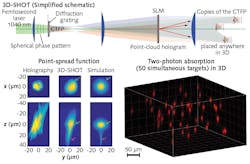3D-SHOT performs optogenetic brain stimulation with single-neuron resolution
A new multiphoton excitation technique developed by researchers at the University of California, Berkeley, called three-dimensional scanless holographic optogenetics with temporal focusing (3D-SHOT), allows on-demand optogenetic photostimulation of custom neuron ensembles. Among existing two-photon photostimulation techniques, raster scanning lacks the necessary temporal precision to activate large sets of neurons simultaneously, and computer-generated holographic (CGH) illumination requires high-numerical-aperture optics that restrict targeting to small 3D volumes. 3D-SHOT addresses all these issues by combining CGH and temporal focusing.
By placing the spatial light modulator (SLM) after a diffraction grating, this new technique first creates a custom temporally focused illumination pattern (CTFP) matched to the characteristic dimensions of a neuron. Then, all-optical convolution with a 3D point cloud hologram places identical copies of the CTFP precisely in space and time on all targeted neurons. The point-spread function measures two-photon absorption in 3D near a single target, showing that 3D-SHOT better concentrates photoexcitation within the addressable volume compared to conventional two-photon holography. The resulting technology can simultaneously activate custom neuron ensembles located anywhere in 3D within the accessible volume of the microscope, and with single-neuron spatial resolution at speeds only limited by the frame rate of the SLM. Reference: N. C. Pégard et al., Nat. Commun. online (Oct. 31, 2017); https://www.nature.com/articles/s41467-017-01031-3.

Gail Overton | Senior Editor (2004-2020)
Gail has more than 30 years of engineering, marketing, product management, and editorial experience in the photonics and optical communications industry. Before joining the staff at Laser Focus World in 2004, she held many product management and product marketing roles in the fiber-optics industry, most notably at Hughes (El Segundo, CA), GTE Labs (Waltham, MA), Corning (Corning, NY), Photon Kinetics (Beaverton, OR), and Newport Corporation (Irvine, CA). During her marketing career, Gail published articles in WDM Solutions and Sensors magazine and traveled internationally to conduct product and sales training. Gail received her BS degree in physics, with an emphasis in optics, from San Diego State University in San Diego, CA in May 1986.
